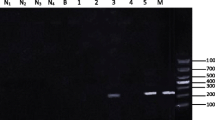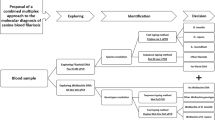Abstract
The heartworm Dirofilaria immitis is the causative agent of dirofilariasis in dogs. Studies have shown that parasite-derived cell-free DNA (cfDNA) can be detected in host blood and may be a promising diagnostic marker for parasitic infections. Thus, our aim was to detect D. immitis-derived cfDNA in host serum by nested PCR. Sera were collected from 12 dogs with natural D. immitis infections; eight were microfilaria (mf)-positive, and the remaining four were mf-negative. Culture fluids derived from single-sex adult D. immitis worms (mf-producing females and males) were also tested for cfDNA. All mf-positive sera were positive by nested PCR, whereas no amplification products were detected in mf-negative sera. The culture fluid of mf-producing females was positive by nested PCR but that of males was negative. All products amplified by nested PCR were sequenced to confirm that the amplicons were those of D. immitis. These results indicate that D. immitis DNA circulates freely in dog serum, except in mf-negative dogs. Additionally, D. immitis cfDNA may primarily be derived from the mf, and adult worms appeared to be minor contributors of cfDNA concentrations in serum; however, the contribution of D. immitis cfDNA derived from larvae of other developmental stages is unclear. An evaluation of the kinetics of D. immitis cfDNA in host serum throughout the parasite life cycle could facilitate the development of early molecular diagnostic techniques. To the best of our knowledge, this is the first report of the detection of mitochondrial DNA from a filarial parasite in host serum.
Similar content being viewed by others
References
Albers A, Sartono E, Wahyuni S et al (2014) Real-time PCR detection of the HhaI tandem DNA repeat in pre- and post-patent Brugia malayi infections: a study in Indonesian transmigrants. Parasit Vectors 7:146
Bendich A, Wilczok T, Borenfreund E (1965) Circulating DNA as a possible factor in oncogenesis. Science 148:374–376
Buppan P, Putaporntip C, Pattanawong U et al (2010) Comparative detection of Plasmodium vivax and Plasmodium falciparum DNA in saliva and urine samples from symptomatic malaria patients in a low endemic area. Malar J 9:72
Butt AN, Swaminathan R (2008) Overview of circulating nucleic acids in plasma/serum. Ann N Y Acad Sci 1137:236–242
Casiraghi M, Anderson TJ, Bandi C et al (2001) A phylogenetic analysis of filarial nematodes: comparison with the phylogeny of Wolbachia endosymbionts. Parasitology 122:93–103
Chan AKC, Chiu RWK, Lo YMD (2003) Cell-free nucleic acids in plasma, serum and urine: a new tool in molecular diagnosis. Ann Clin Biochem 40:122–130
Emlen W, Mannik M (1984) Effect of DNA size and strandedness on the in vivo clearance and organ localization of DNA. Clin Exp Immunol 56:185–192
Enk MJ, Oliveira e Silva G, Rodrigues NB (2012) Diagnostic accuracy and applicability of a PCR system for the detection of Schistosoma mansoni DNA in human urine samples from an endemic area. PLoS ONE 7:e38947
Fleischhacker M, Schmidt B (2007) Circulating nucleic acids (CNAs) and cancer—a survey. Biochim Biophys Acta 1775:181–232
Furtado AF, Abath FG, Regis L et al (1997) Improvement and application of a polymerase chain reaction system for detection of Wuchereria bancrofti in Culex quinquefasciatus and human blood samples. Mem Inst Oswaldo Cruz 92:85–86
Hussein HM, El-Tonsy MM, Tawfik RA, Ahmed SA-E-G (2012) Experimental study for early diagnosis of prepatent schistosomiasis mansoni by detection of free circulating DNA in serum. Parasitol Res 111:475–478
Kato-Hayashi N, Yasuda M, Yuasa J et al (2013) Use of cell-free circulating schistosome DNA in serum, urine, semen, and saliva to monitor a case of refractory imported schistosomiasis hematobia. J Clin Microbiol 51:3435–3438
Kato-Hayashi N, Leonardo LR, Arevalo NL et al (2015) Detection of active schistosome infection by cell-free circulating DNA of Schistosoma japonicum in highly endemic areas in Sorsogon Province, the Philippines. Acta Trop 141:178–183
Khairnar K, Parija SC (2008) Detection of Entamoeba histolytica DNA in the saliva of amoebic liver abscess patients who received prior treatment with metronidazole. J Health Popul Nutr 26:418–425
Lo YMD, Zhang J, Leung TN et al (1999) Rapid clearance of fetal DNA from maternal plasma. Am J Hum Genet 64:218–224
Lodh N, Mwansa JCL, Mutengo MM, Shiff CJ (2013) Diagnosis of Schistosoma mansoni without the stool: comparison of three diagnostic tests to detect Schistosoma mansoni infection from filtered urine in Zambia. Am J Trop Med Hyg 89:46–50
Lucena WA, Dhalia R, Abath FG et al (1998) Diagnosis of Wuchereria bancrofti infection by the polymerase chain reaction using urine and day blood samples from amicrofilaraemic patients. Trans R Soc Trop Med Hyg 92:290–293
McCarthy JS, Zhong M, Gopinath R et al (1996) Evaluation of a polymerase chain reaction-based assay for diagnosis of Wuchereria bancrofti infection. J Infect Dis 173:1510–1514
McHaffie J (2012) Dirofilaria immitis and Wolbachia pipientis: a thorough investigation of the symbiosis responsible for canine heartworm disease. Parasitol Res 110:499–502
Mehra N, Penning M, Maas J et al (2007) Circulating mitochondrial nucleic acids have prognostic value for survival in patients with advanced prostate cancer. Clin Cancer Res 13:421–426
Mharakurwa S, Simoloka C, Thuma PE et al (2006) PCR detection of Plasmodium falciparum in human urine and saliva samples. Malar J 5:103
Nwakanma DC, Gomez-Escobar N, Walther M et al (2009) Quantitative detection of Plasmodium falciparum DNA in saliva, blood, and urine. J Infect Dis 199:1567–1574
Parija SC, Khairnar K (2007) Detection of excretory Entamoeba histolytica DNA in the urine, and detection of E. histolytica DNA and lectin antigen in the liver abscess pus for the diagnosis of amoebic liver abscess. BMC Microbiol 7:41
Pontes LA, Oliveira MC, Katz N et al (2003) Comparison of a polymerase chain reaction and the Kato-Katz technique for diagnosing infection with Schistosoma mansoni. Am J Trop Med Hyg 68:652–656
Sandoval N, Siles-Lucas M, Pérez-Arellano JL et al (2006) A new PCR-based approach for the specific amplification of DNA from different Schistosoma species applicable to human urine samples. Parasitology 133:581–587
Schwarzenbach H, Hoon DSB, Pantel K (2011) Cell-free nucleic acids as biomarkers in cancer patients. Nat Rev Cancer 11:426–437
Simón MF, Siles-Lucas M, Morchón R et al (2012) Human and animal dirofilariasis: the emergence of a zoonotic mosaic. Clin Microbiol Rev 25:507–544
Wichmann D, Panning M, Quack T et al (2009) Diagnosing schistosomiasis by detection of cell-free parasite DNA in human plasma. Plos Negl Trop Dis 3:e422
Wichmann D, Poppert S, Von Thien H et al (2013) Prospective European-wide multicentre study on a blood based real-time PCR for the diagnosis of acute schistosomiasis. BMC Infect Dis 13:55
Xu J, Liu A-P, Guo J-J et al (2012) The sources and metabolic dynamics of Schistosoma japonicum DNA in serum of the host. Parasitol Res 112:129–133
Acknowledgments
This work was financially supported in part by a Grant-in-Aid for Scientific Research (No. 26450484) from the Japan Society for the Promotion of Science and the Strategic Research Base Development Program for Private Universities sponsored by the Ministry of Education, Culture, Sports, Science, and Technology of Japan (S1491007). The authors thank Mami Kato at Nihon University for her assistance with the experiments.
Conflict of interest
The authors declare that they have no competing interest.
Compliance with ethical standards
All applicable international, national, and/or institutional guidelines for the care and use of animals were followed.
Author information
Authors and Affiliations
Corresponding author
Rights and permissions
About this article
Cite this article
Oi, M., Sato, Y., Nakagaki, K. et al. Detection of Dirofilaria immitis DNA in host serum by nested PCR. Parasitol Res 114, 3645–3648 (2015). https://doi.org/10.1007/s00436-015-4591-z
Received:
Accepted:
Published:
Issue Date:
DOI: https://doi.org/10.1007/s00436-015-4591-z




